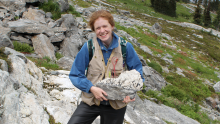UBC oceanographer Stephanie Waterman has been selected as a 2015 Alfred Sloan Research Fellow, receiving $50,000 to further her research. The two-year fellowships honour the achievements of outstanding young scholars in science, mathematics, economics and computer science in Canada and the US.
Waterman, an assistant professor in the department of Earth, Ocean and Atmospheric Sciences, conducts research in the field of physical oceanography, most recently focusing on physics of the Arctic and Southern oceans. This summer she will employ a small, autonomous ocean glider to gather extremely fine-grained environmental and physical measurements of Canada’s Arctic waters.
“Fluid flows can be very complex and beautiful — in the oceans flows occur on a grand scale that you can see and marvel at,” says Waterman. “Understanding the dynamics of these flows is both very satisfying and essential. As we put more and more pressures on our environment, these types of studies become increasingly important because they help us better understand the natural world we live in.”
Her Arctic research is organized in conjunction with the Canadian Arctic GEOTRACES program, an initiative to better understand biogeochemical processes in the ocean and improve projections of the ocean’s response to global change. Waterman’s glider will measure centimetre-scale variations of temperature, salinity and current velocity that can be used to infer turbulent dissipation and mixing rates.
Waterman completed her undergraduate engineering physics studies at Queens University, later pursuing a PhD in physical oceanography at the Massachusetts Institute of Technology and Woods Hole Oceanographic Institution. She was a research fellow at the National Oceanography Centre, the Grantham Institute for Climate Change and the Climate Change Research Centre and ARC Centre of Excellence for Climate System Science before joining UBC in 2014.
“The beginning of a one’s career is a crucial time in the life of a scientist. Building a lab, attracting funding in an increasingly competitive environment, and securing tenure all depend on doing innovative, original high-quality work and having that work recognized,” says Paul L Joskow, president of the Alfred P Sloan Foundation.
“For more than 50 years the Sloan Foundation has been proud to celebrate the achievements of extraordinary young scientists who are pushing the boundaries of scientific knowledge.”
The Sloan Foundation was founded in 1934 by Alfred P Sloan Jr, then-president and CEO of General Motors. Twenty UBC Science researchers have been awarded the fellowship since 1984.

